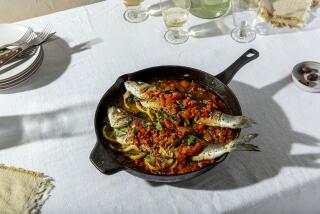New Research Supports Omega-3’s Role in Prevention of Heart Disease
- Share via
WASHINGTON — A group of international researchers, gathered here for the II International Conference on the Health Effects of Omega 3 Fatty Acids in Seafood, fell short of announcing a formal nutritional standard for the nutrient, but they did call for the U. S. National Research Council to reconsider its position and include omega-3 in the Recommended Dietary Allowances.
To date, the U. S. government has refused to include omega-3 in its RDAs, explaining that further study of the fatty acids’ role in metabolic function is necessary.
But, citing research done by members of the group, which charts the amount of omega-3 required to produce a variety of positive responses in either animal models or in patients in a clinical setting, the group described omega-3’s protective effect against chronic illnesses such as cardiovascular disease, rheumatoid arthritis, diabetes and psoriasis and determined that it does indeed have an essential role in human growth and development.
At a press conference, representatives from the United States and the United Kingdom suggested that a minimum of 1% of a day’s total calories be derived from omega-3 fatty acids--the type found primarily in fish that inhabit deep, cold waters. That percentage could be achieved by eating two to three meals of fish per week from sources such as tuna, salmon, mackerel, herring or sardines, the scientists said. The American Heart Assn. and the American Dietetic Assn. already encourage consumers to eat fish two to three times a week but no health organization has recommended a specific amount for omega-3.
Clinical studies have proven that for proper functioning, the body needs to derive only about 2% of its total calories from fat--of all types--yet Americans currently consume about 30%--most of it from saturated fat, according to health experts. Eating more fish would presumably replace some of the saturated fat with polyunsaturated fat and simultaneously supply omega-3 to the diet. Equal distribution of each type--10% saturated, 10% polyunsaturated and 10% monounsaturated--is optimal, all health agencies concur.
“I think (eating fish) is something very healthy to do,” said Evelyn Tribole, a registered dietitian and media spokesperson for the American Dietetic Assn. “Canned tuna contains omega-3, and (the nutrient) is available in the water-packed variety too.
“I would prefer a recommendation in terms of an absolute number of grams rather than a percentage because it’s not as absolute. There are a number of Americans who are dieting on any given day so that their total caloric intake is variable. But with two to three meals (of fish) a week you know you’re at least in the ballpark.”
Tribole also cautioned against meeting this requirement with supplements because they will add additional fat to the diet.
“I recommend that my patients rotate the use of oils--canola oil, then safflower, then olive. The more variety you have the more likely you are to maximize nutrients and minimize toxicity.” (It is possible to eat too much of one type of fat and cause an imbalance, leading to toxicity, in the body.)
Dr. Michael Crawford of the Institute of Zoology, London, also believes in balance and explained that prevention of chronic diseases is one of the most logical applications of omega-3. He and many other scientists at the meeting agreed that even though the evidence examines intervention, the data should encourage consumers to seek balance in the diet and include nutrients from a variety of sources--including those containing omega-3--to delay the onset of disease.
The doctors explained that although American consumers have made an effort to switch from saturated fat to polyunsaturated fat, the United States still has a high mortality rate from degenerative disease. But, according to early studies of Greenland Eskimos, who also consume large amounts of saturated fat from whale blubber and very fatty fish, some of the negative effects of a high-saturated fat diet can be reduced by the omega-3s in the fatty fish.
“The evidence is clear that the seeds of coronary artery disease are already being sewn in childhood so we’re looking at doing things in terms of initial nutrition,” Crawford said. “We’re not just talking about giving people with heart disease or rheumatoid arthritis some fish oils. We’re looking at stopping these (diseases) from starting in the first place.”
Bill Lands, professor of Biological Chemistry at the University of Illinois, agreed. He described a study of 6,000 high-risk middle-aged men that noted a 40% lower mortality rate among fish-eating Americans, compared to the non-fish eating group. In the Multiple Risk Factor Intervention Trial (MRFIT), participants were studied over a 10-to-12-year period to investigate a number of risk factors for coronary heart disease, including diet, blood pressure and smoking.
A similar result was observed in a significant study published last year in the Lancet, a British medical journal. It reported that of the nearly 2,000 men who had previously had a heart attack, those who were advised to eat at least two oil-rich fish meals per week had a 29% lower mortality rate over the next two years compared to those who were not advised to eat fish.
“Whatever is in the food chain is in the tissues. There’s not much discrimination (by the body),” Lands said. “Epidemiology tells us that those with omega-3 (in their tissues) have a 40% lower mortality rate.” Until all the evidence is in, consumers can follow the AHA recommendation to include more fish meals in the diet.
“Eat Fish, Live Better” (Harper & Row: $18.95) by Anne M. Fletcher, a registered dietitian, can help consumers further appreciate the benefits of fish oils.
In addition to recipes and some discussion of fish-oil capsules, the book features an easy-to-understand explanation of the role of omega-3 in the diet, including how it influences hormone function. Early population studies are discussed, and a detailed section on pesticides, pollutants and poisoning associated with eating fish is provided.
There is an extensive glossary, which ranges from anchovy to wolfish. In it, each species is defined in terms of its pseudonyms, market forms, eating quality, methods of preparation and nutritional value.
GRILLED TUNA IN TOMATO-BASIL-MINT SAUCE
(From “Eat Fish, Live Better”)
1 (16-ounce) can stewed tomatoes, drained
1 medium clove garlic
1/4 cup basil leaves
10 large mint leaves
Pepper
1 tablespoon olive oil
2 tablespoons dry Sherry
1 1/4 to 1 1/3 pounds fresh tuna steaks, 3/4 to 1-inch thick
Blend tomatoes and garlic in blender 20 to 30 seconds or until frothy and fine. Add basil and mint and blend 10 seconds. Pour mixture into saucepan and season to taste with pepper. Add oil, then bring to boil. Reduce heat and simmer, uncovered, 20 to 25 minutes. Stir in Sherry, then remove from heat.
Spread coating of sauce on one side of fish and place on preheated, lightly oiled grill. Grill fish, sauce side down, 5 to 7 minutes. Repeat with other side and cook until done. Serve with remaining sauce. Makes 4 servings.
TUNA TACOS
(From “Eat Fish, Live Better”)
1/4 cup packaged taco seasoning mix
1 (8-ounce) can no-salt added tomato sauce
2/3 cup water
2 (6 1/2-ounce) cans water-packed less salt tuna, drained and flaked
10 prepared taco shells
3 ounces shredded low-fat cheese
1/2 cup plus 2 tablespoons prepared salsa
1/2 cup chopped onion
2 1/2 cups shredded lettuce
Combine taco seasoning mix, tomato sauce and water. Bring to boil, then reduce heat and simmer, uncovered 5 to 7 minutes. Stir occasionally. Remove from heat.
Stir tuna into mixture, then divide evenly among taco shells. Top with shredded cheese. Place on baking sheet and bake at 350 degrees 5 to 7 minutes. Serve with salsa, onion and lettuce. Makes 10 servings.
SPRING SARDINE KNACKEBROD
1 (8-ounce) package Neufchatel cheese, softened
1 tablespoon prepared mustard
1 tablespoon reduced-calorie mayonnaise
1 tablespoon finely chopped green onion
2 teaspoons lemon juice
2 (3 3/4-ounce) cans sardines in oil, drained
1 round Scandinavian knackebrod cracker, about 10 inches in diameter
1 1/2 to 2 cups desired toppings: sliced tomatoes, cucumber, radishes, red onion, sweet red and green pepper, black or green olives, hard-cooked eggs, cooked tiny red potatoes, capers, dill or parsley sprigs
Lemon wedges
Combine cheese, mustard, mayonnaise, green onion, lemon juice and half of sardines in bowl. Mix thoroughly. Spread on knackebrod.
Arrange remaining sardines and desired garnishes on top. Cut into serving pieces and serve immediately with lemon. Makes 4 main dishes or 8 to 10 appetizer servings.
Note: Knackebrod is available in cracker or gourmet sections of most supermarkets. Crisp rye crackers may be substituted.
TUNA LINGUINE
1 (16-ounce) can cling peach slices, in juice
1 (12-ounce) package herbed or egg linguine
1/4 cup butter or margarine
2 cloves garlic, minced
1/2 cup chopped onion
2 cups sliced asparagus or green beans
1/2 teaspoon dried basil,, crushed
1/2 teaspoon dried dill weed, crushed
1/2 teaspoon salt
1/4 teaspoon ground nutmeg
1/4 cup white wine
1 cup low-fat sour cream
1 cup low-fat Swiss cheese
1 (6 1/2-ounce) can tuna, in water
1 cup cherry tomatoes, halved
Drain peaches, reserving juice for other use.
Cook linguine as package directs.
Heat 3 tablespoons butter with garlic until butter melts. Toss with linguine. Keep warm.
Melt remaining 1 tablespoon butter in 10-inch skillet. Saute onion until tender. Add asparagus and cook until tender-crisp. Stir in basil, dill, salt and nutmeg. Blend in wine, sour cream and cheese. Cook over low heat, stirring constantly, until cheese melts. Stir in peach slices, tuna and cherry tomatoes. Heat through. Toss lightly with linguine to serve. Makes 4 servings.
SALMON ON SKEWERS
2 pounds salmon, cut into 1 1/2-inch cubes
1/4 cup lemon juice
Fresh dill weed
Salt, pepper
1 pound mushrooms
1/2 cup olive oil
Combine salmon, lemon juice, dill and season to taste with salt and pepper. Marinate in refrigerator 6 hours.
When ready to cook, alternate mushroom caps and salmon cubes on skewers, ending with mushroom. Brush with oil and broil or grill, turning several times, about 10 minutes per inch thickness. Makes 3 to 4 servings.
SALMON PROVENCAL
1 pound salmon steaks or fillets
3 tablespoons olive oil
1 large clove garlic, minced
1/2 small onion, sliced
1 small zucchini, cut in half and sliced
1 small sweet red pepper, cut into rings
1/2 cup cherry tomatoes, halved
12 black olives, sliced in half lengthwise
2 tablespoons chopped parsley
Salt, pepper
2 lemon wedges
Rinse salmon and pat dry. Heat 1 tablespoon oil in skillet. Add garlic, onion, zucchini and sweet red pepper. Saute over medium heat 2 to 3 minutes. Add tomatoes, olives and parsley.
Saute 10 to 12 minutes per inch thickness or until fish flakes easily when tested with fork at thickest part. Return zucchini mixture to skillet and heat through. Season to taste with salt and pepper. Squeeze lemon over all. Makes 3 to 4 servings.
RELATED STORY: H33
Two recent studies demonstrate that eating fish can lower blood pressure.






